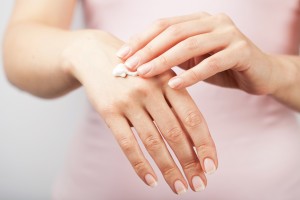Winter comes in various forms depending on the region, and the same can be said for your skin. As the scenery shifts from fall to winter the effects of cold temperatures, winds, rain and snow start revealing themselves from head to toe. Whether dealing with chapped lips or cracked cuticles, this list of cold weather skin solutions will help you stay hydrated, moisturized, and feeling vibrant during the winter months.
Face, Ears and Neck
During summer months, sunscreen is a no-brainer. Nearly everyone has a horror story of the time they forgot to apply their SPF 30 and felt the effects of sunburn. The obvious pairing of hot weather and sunscreen makes it easy to forget that prolonged time outdoors should be accompanied with UVA and UVB protectors year round. Try and use daily moisturizers and lip balms with a minimum of SPF 15 already included to protect your skin 365 days a year.
To further help protect your face, ears, and neck, keep them covered in extreme temperatures. Blustery winds not only dry out your skin, they introduce a variety of miniscule seasonal elements that can irritate your pores. And keep in mind that cold weather triggers heaters to kick on indoors, and that can result in red, itchy, dry skin. If your daily moisturizer (with SPF 15!) isn’t doing the trick, consult a dermatologist and find a deep relief product for cracks and rashes. Also, stay away from astringents that further dry out skin.
Hands

Keeping your hands healthy during the winter months can be linked to the same theories used in treating your face, ears, and neck, however it’s important to understand that hands often take the brunt of cold weather assaults. Cracked knuckles and split cuticles are two of the most common ails during winter weather, and can be treated with a variety creams. It’s worth doing a bit of research about which cream may be best, and dermatologists recommend choosing one that’s fragrance free and as natural as possible. Keep an eye out for lotions and creams that contain avocado or primrose oils to promote absorption and reduce clogging.
When it comes to outerwear for your hands, it’s important to protect them with gloves that are effective. Skip the cotton and go for gloves with insulation or a leather exterior, and stay away from wool that may irritate already dry and itchy skin.
Torso, Legs and Toes
While your body receives the most cold weather symptoms from the waist up, there’s still risk of eczema and dry skin on your torso, legs, and feet. It’s always important to moisturize after showering, but even more so in the winter months. Immediately after stepping out of a steamy shower be sure to replenish your skin with a nourishing moisturizer (stay away from petroleum based products). Another trick to help your skin stay hydrated is by using a humidifier at night. Heating systems draw out moisture in the air and a humidifier will help replenish water to the air and subsequently to your skin.
The Golden Rule – Drink Water!
Hydrating is the golden rule of skin care. Drinking water will treat your dry skin from the inside out, and is an important aspect of health in general. Not only does water promote your skin’s elasticity, it also regulates body temperature and aids with digestion and brain function.
